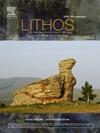The operation of plate tectonics in Earth's middle age: Constraints from ∼1.4 Ga calc-alkaline arc magmatism in the southern CAOB
IF 2.5
2区 地球科学
Q2 GEOCHEMISTRY & GEOPHYSICS
引用次数: 0
Abstract
The Mesoproterozoic (1.6–1.0 Ga) era recorded the supercontinent transition from Nuna to Rodinia supercontinent. However, the global tectonic style within this age interval remains highly debated (plate tectonics vs lid tectonics), largely due to the occurrence of widespread continental rifting sequences, alkaline and anhydrous magmatism, along with high T/P metamorphism. We here systematically investigated the whole-rock geochemical, geochronological, and Nd-Hf isotopic characters of metamorphosed Mesoproterozoic granodiorite and monzogranite within the Alxa Block in the central segment of the southern CAOB. The field geology and obtained data indicate that they are typical of I-type granitoids emplaced at 1.43–1.40 Ga, with their parental magmas generated by partial melting of preexisted juvenile mafic crusts. These granitoids belong to the calc-alkaline and magnesian series, and are enriched in LREE and LILE. Moreover, their parental magma contains high magmatic H2O contents (>7 %). The data patterns, combined with regional geology, indicate these granitoids are continental arc magmatic rocks. Our data, together with those published data in the microcontinental blocks of southern CAOB, argue that the protracted (1.51–1.40 Ga) calc-alkaline granitic magmatism in these blocks was generated in a continental marginal arc. This prolonged continental arc system coincides well with the Great Proterozoic Accretionary Orogen (GPAO) in the Mesoproterozoic and must have been formed outboard the GPAO. Furthermore, a review of global geological and geochemical data patterns favor widespread subduction on the periphery of Nuna and the operation of plate tectonics in the Mesoproterozoic.
地球中世纪板块构造活动:来自CAOB南部~ 1.4 Ga钙碱性弧岩浆活动的约束
中元古代(1.6 ~ 1.0 Ga)是由Nuna超大陆向Rodinia超大陆过渡的时期。然而,这一年龄区间内的全球构造样式(板块构造vs盖构造)仍然存在高度争议,这主要是由于广泛的大陆裂陷序列、碱性和无水岩浆活动以及高T/P变质作用的发生。本文系统地研究了华南中段阿拉善地块中元古代变质花岗闪长岩和二长花岗岩的全岩地球化学、年代学和Nd-Hf同位素特征。野外地质和实测资料表明,它们是典型的位于1.43 ~ 1.40 Ga的i型花岗岩,母岩浆是由早生的幼基性地壳部分熔融形成的。这些花岗岩属钙碱性和镁质系列,富含轻稀土和LILE。此外,它们的母岩浆含有较高的岩浆水含量(> 7%)。结合区域地质资料,表明这些花岗岩类为大陆弧岩浆岩。结合已发表的南CAOB微陆块资料,认为南CAOB微陆块的持续(1.51 ~ 1.40 Ga)钙碱性花岗质岩浆活动起源于大陆边缘弧。这一延长的大陆弧体系与中元古代的大元古代增生造山带(GPAO)吻合良好,可能形成于大元古代增生造山带外。此外,回顾全球地质和地球化学资料模式,有利于努纳边缘广泛的俯冲作用和中元古代板块构造的作用。
本文章由计算机程序翻译,如有差异,请以英文原文为准。
求助全文
约1分钟内获得全文
求助全文
来源期刊

Lithos
地学-地球化学与地球物理
CiteScore
6.80
自引率
11.40%
发文量
286
审稿时长
3.5 months
期刊介绍:
Lithos publishes original research papers on the petrology, geochemistry and petrogenesis of igneous and metamorphic rocks. Papers on mineralogy/mineral physics related to petrology and petrogenetic problems are also welcomed.
 求助内容:
求助内容: 应助结果提醒方式:
应助结果提醒方式:


